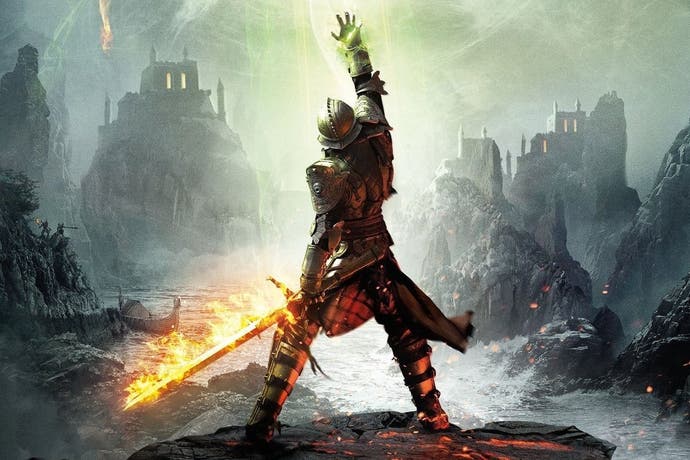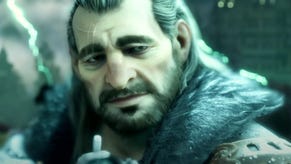Last-gen revisited: Dragon Age Inquisition
Do you really need a PS4 or Xbox One to enjoy BioWare's latest adventure?
The support that PlayStation 3 and Xbox 360 continue to receive is really unprecedented. While it's not uncommon for older platforms to remain supported years after they've been replaced, it's rare to find so many of the latest AAA releases appearing across multiple generations. Those of us that are quick to jump to the latest hardware would never dream of going back and playing these games in a compromised state but, for many people, it's the only option. The important question here: are these games really playable and enjoyable on last-generation consoles? Or is a PS4 or Xbox One upgrade now effectively mandatory?
Dragon Age: Inquisition is an interesting release, then, as it marks the beginning of BioWare's new Frostbite 3 initiative and was designed first and foremost for the new console generation. At first glance, it's clear that from a visual perspective, the last-generation edition is a huge step back from other versions of the game. Many of the finer details are lost in this translation leaving the game looking somewhat plain and garish in comparison. While the same basic art direction still shines through, stripping away the polish lavished upon the more advanced versions of the game definitely has an impact on the experience. Yet, this isn't an action game, nor have BioWare's previous console efforts shone as a beacon of excellent performance. So there's an interesting opportunity here - this new title may not match the full next-gen experience, but it could well improve upon the mixed performance of previous Dragon Age titles.
As noted, this is a Frostbite 3 game and, as such, it's not surprising that the PS3 and 360 versions of the game share a lot in common with previous titles built using this technology. As with Battlefield 4, the game operates at 1280x704 resolution - basically 720p with eight pixels subtracted from the top and bottom - with a pair of comparable anti-aliasing solutions. The PS3 version uses an MLAA seen in the Battlefield games, while Xbox 360 features a standard FXAA implementation. The game is sharper but more aliased on PS3 while FXAA delivers a smoother, yet blurrier, image. The 360 version also includes an optional install disc which, as with other Frostbite games before it, allows for higher quality assets in line with the PS3 version.
Jumping directly from the current-gen version of the game to this PS3/360 release is quite a shock, initially. Detail has been pared back dramatically across the board, while lighting and effects work has been reduced in quality and precision as well. Right out of the gate, the differences are clear, but it's not until you first reach the Hinterlands that the changes become most apparent. Hills that were once ripe with plant life now appear completely barren, with minimal foliage popping in at very close proximity. World geometry has been scaled back and LOD scaling for everything is extremely aggressive. Cloth physics are pared back, the ocean simulation simplified, and many of the game's visual flourishes simply haven't been replaced at all. It's very plain in comparison.
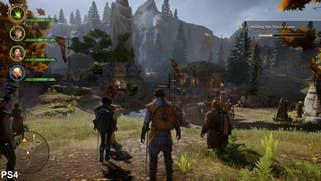

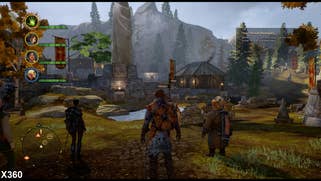
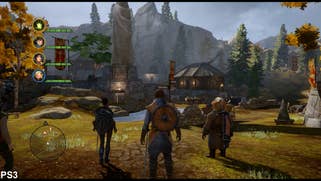
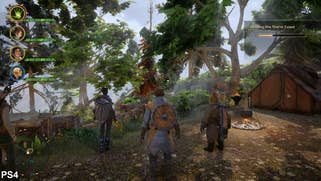

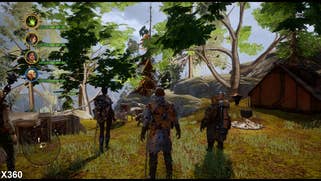
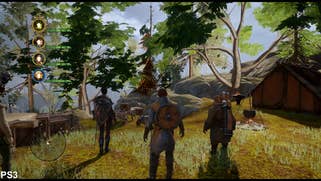


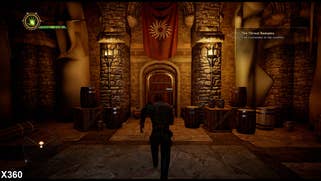
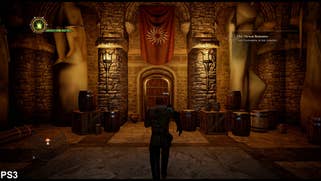
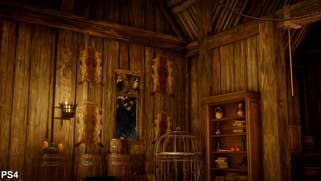

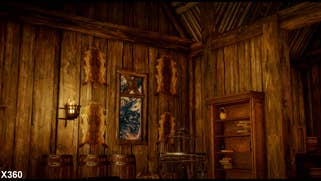



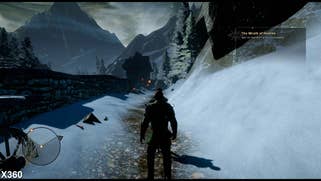
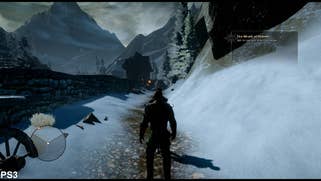




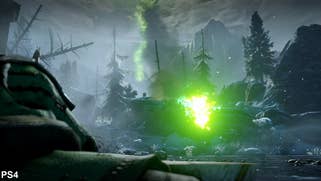



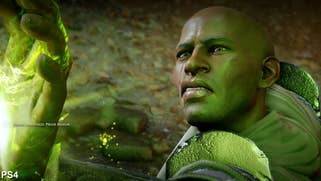
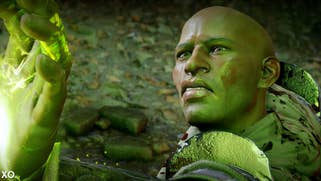


Texture streaming is an issue, particularly on 360, where some assets can take upwards of 10 seconds to load in, resulting in some very blurry sequences. In fact, there are cut-scenes in which entire sections are completely devoid of proper textures, leaving unimportant NPCs a completely blurry mess throughout. Even when loaded in completely, the texture quality takes a huge step back across the board. It's not just texture resolution but variety that takes a hit, with the now barren terrain looking almost tiled in the last-gen version.
Then there are the loading times. On PS4 and Xbox One this was already an issue to some extent, but the size of the areas prevented it from souring the experience. On PS3 and 360, however, we're looking at significantly longer wait times between areas lasting upwards of 70-80 seconds. Loading times are long enough that it could potentially deter players from completing certain tasks due to the added tedium.
Frame-rate is another area where Inquisition falls a bit flat. The current-generation version of the game delivers a very solid performance on both consoles, but last-generation machines don't fare nearly as well. While exploration manages to hold a reasonably steady average frame-rate, major battles see dips well into the low 20s and sometimes into the teens. On PS3 the game uses a triple buffered v-sync setup that completely sidesteps any tearing issues. It doesn't feel great, due to the serious dips the game often suffers, but it's actually better on average in comparison to most of BioWare's PS3 output. Xbox 360, however, produces some rather grim results with frame-rates just as low as PS3 in most situations yet, thanks to an adaptive v-sync setup, we see near-constant torn frames during normal gameplay. A sub-30fps frame-rate combined with heavy screen tearing just isn't acceptable in 2014 and definitely impacts the fluidity of the experience.
Alternative comparisons:
Keeping all of this in mind, if we had to make a choice between the two versions, we would have to give the nod to the PlayStation 3 release. The average frame-rate in both versions of the game is very similar but the lack of screen tearing on PS3 makes a world of difference in terms of presentation. Furthermore, texture streaming performance is quite a bit faster and MLAA often produces a more pleasing image, despite some limited coverage in certain areas.
With stripped-down visuals, long loading times and relatively poor performance, it seems like it would be difficult to recommend these versions of the games, right? Well, for many users, that's definitely the case, but if you really look back over this past generation it certainly seems that the game should be quite playable for many people. You see, open-ended Western RPGs have become rather popular in the last several years yet, in nearly every case, the console versions of those games have run at unstable frame-rates with lots of detail pared back. Compare Inquisition to something like the previous Dragon Age titles or one of Bethesda Softworks' games and it doesn't seem so bad. In fact, in many ways, the PS3 and Xbox 360 versions of Inquisition actually look and run a good deal better than Dragon Age: Origins.
So, in that sense, we think the teams responsible have produced solid work overall. Keeping in mind the limitations of last-generation machines, they've produced a game that stacks up fairly well with its system mates. Dragon Age isn't a twitchy action game after all, and although the low frame-rate is visually unappealing the game never really becomes unplayable. Features aren't lost either - unlike Battlefield 3 and 4, where the scale of the game was reduced to accommodate the ageing machines.
This is the same game we played on PS4 and Xbox One with visuals about on par with the average open-ended last-generation RPG. If you're someone that cares about performance or image quality you've probably already got a powerful PC or at least one of the latest consoles. For those that are sticking with one of the older consoles, however, it's still possible to enjoy Dragon Age: Inquisition - especially if you're already accustomed to other similar games on these platforms.
